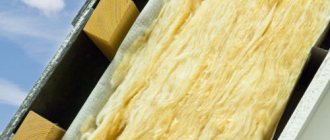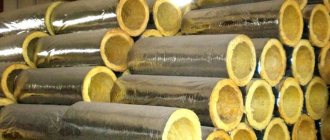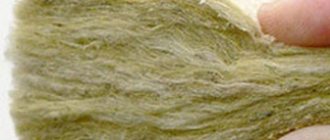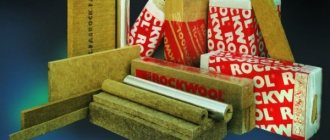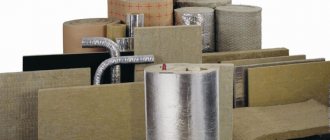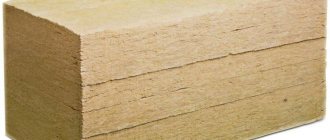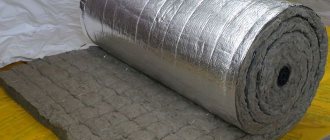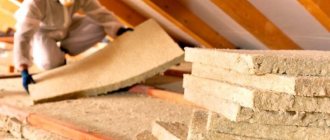Basalt wool is designed primarily to serve as insulation and retain heat in our homes in winter and keep cool in summer. The remarkable properties of the material allow it to be used on a large industrial scale, as well as in civil engineering. Basalt wool is widely used when carrying out work on thermal insulation of objects, and in addition serves as an excellent soundproofing tool.
Modern designers, when creating a new project, are very wary of new advertised building materials. This is due to past mistakes, when the construction complex sought to produce square meters in accordance with the tasks of the planned economy, without caring at all about the materials used, and without thinking about their impact on humans.
Recently, doctors have been sounding the alarm, expressing the opinion that the use of low-quality materials in the housing complex leads to asthma or, even worse, causes cancer problems. Particularly sensitive is the issue of using various heat-insulating materials; as a rule, they are covered with building structures and can affect us completely unnoticed.
Is basalt wool harmful to health?
Gaining enormous popularity as a heat and sound insulating material, we increasingly argue: is basalt wool harmful to human health or is its use absolutely harmless? The question is not an idle one, and our review is intended to understand how realistically the use of such material can be dangerous to human health.
City residents are increasingly thinking about the environmental safety of our living environment. Outside the windows of our homes, dozens of factories produce products, burning tons of gas and oil products, polluting the atmosphere with harmful substances. What can we say about the endlessly growing fleet of cars that undergo annual maintenance, but strangely leave behind clouds of black smoke exceeding all imaginable CO2 standards.
Nevertheless, all these harmful exhausts are carried somewhere into the distance by the wind, CO2 evaporates into the vast atmosphere and generally happens somewhere in the city with them, and not with us - our brain is lulled into a stream of consciousness. We worry much more about ourselves and our loved ones, we monitor proper nutrition, counting the numbers of preservatives on jars.
We are concerned about what the tiles, wallpaper, floors, and furniture in our home are made of. When planning the construction of a cottage or intending to carry out a long-planned renovation, we are increasingly taking a more responsible approach to the choice of noise and heat insulation materials. Understanding that we will have to live and come into contact with these substances for many years. For example, everyone knows that careless handling of glass wool leads to serious consequences, ranging from discomfort from needles to allergic reactions.
Here it’s probably worth taking a break and saying a few words about what this prickly material, familiar from childhood, is like.
Features of the composition as the main disadvantage of insulation
The main components of the material are rocks or metamorphic rocks. This makes cotton wool as natural and environmentally friendly as possible. However, the binders used to give the insulation strength cannot always be classified as safe for health. For example, phenol is the best binder, providing maximum strength, but can cause adverse reactions with prolonged contact with the material.
Advice! Of course, if the facades of a house are insulated with cotton wool, then nothing threatens the residents, but if it is used to soundproof a room, it is better to opt for products that contain clay or acrylic, which are completely safe for the body.
Glass wool or basalt wool, which is better?
Glass wool is a fibrous mineral material. Nothing more than one of the types of mineral wool. In the production of glass wool, raw materials are used that are exactly the same as those that serve as a component of ordinary glass. Often recycled, collected material or waste from the glass industry is used. But wait, if this is a mineral material, then where is the danger, please explain to me, glass wool or basalt wool, which is better?
We know of three modifications of fibrous heat insulators made from mineral components:
- glass wool;
- basalt wool;
- slag.
If everything is clear with the first, there are no problems with the third either, it is made from molten blast furnace slag, and in fairness, we note that it is rarely found on construction markets, then I think it’s time to find out what the second is made of.
Basalt wool or mineral wool, which is better?
Basalt wool is an artificially produced, inorganic material. It is made by melting natural minerals and further forming them into a fibrous structure. Natural mineral - volcanic stone of basalt rock. That is why we can often hear the definition of mineral stone wool . Accordingly, the question of basalt wool or mineral wool, which is better, after finding out that they are the same thing, disappears by itself.
Mineral wool – goodbye or welcome?
Even now, mineral wool, especially slabs and sandwich panels based on it, is a fairly popular insulation material in Russia.
Mineral wool is used for insulating pipes, utility rooms or houses from almost all sides: for insulating the walls of a house outside and inside, facades, ceilings, attics, attics, loggias, as well as for sound insulation and noise insulation. Where to buy mineral wool? Anywhere. Mineral wool is sold on any construction market and on any specialized websites on the Internet. At the moment, on the Russian market you can purchase many mineral wool products from various manufacturers. There are various types of mineral wool insulation on the market: foiled mineral wool, acoustic mineral wool, pierced mats, thermal insulation cords, sandwich panels, slabs, cylinders, rolls, etc. Mineral wool insulation is produced in various sizes and densities. Of course, impeccable mineral wool insulation is a dream that has not yet become a tangible reality. Numerous attempts to create a high-quality heat insulator for equipping building structures have not yet led to a productive result.
However, the work of engineers and chemists who are working hard to invent an impeccable thermal insulation material based on mineral wool still cannot be called unproductive. The new generation of insulation materials differs significantly from historical predecessors in a significant number of technical indicators. In addition to improving technical characteristics, the development area extended to ensuring ease of installation and increasing wear resistance. There have been successes, but it is still necessary to choose and evaluate the advantages and disadvantages.
Those who want to equip their country home or city apartment with a layer of insulation still have to choose, carefully weighing the disadvantages and convincing advantages of each material. Having added up the negative and positive qualities into a certain sum, the consumer decides whether mineral wool is suitable for him. What does a modern buyer need from a heat insulator? The buyer, that is, the owner of a residential or commercial property, a country house or small cottage under construction, is interested in such qualities of thermal insulation materials as minimal operational thermal conductivity, which does not change depending on the complexity of the conditions, the absence of thermal expansion and the preservation of structural bonds when exposed to moisture.
Of course, a decent insulation also requires good performance in high- and low-temperature conditions, long-term operational life, resistance to biological effects and safety. On many of these points, mineral wool is still able to beat its competitors.
Unique structure
Before we talk in detail about all the pros and cons of mineral wool as insulation, let’s first understand what mineral wool is.
Stone wool, called “mineral wool” by builders, is a heat-insulating material with a chaotic fibrous structure. Stone wool is produced from basalt rocks by melting the raw material at a temperature of approximately 1500 degrees and then subjecting the melt to a powerful air flow in a centrifuge, which results in the formation of basalt fibers. During the production process, special hydrophobic (water-repellent) and binders are added. A pendulum spreader gives the basalt fibers a chaotic direction, laying out the future wool fibers on the conveyor in several multidirectional layers. Next, the material enters the corrugator, which presses the carpet from the fibers. This is necessary so that the stone wool acquires the required density.
Then the basalt fibers are placed in a polymerization chamber, where at a temperature of about 200 degrees they harden, forming the final product. At the last stage, the material is cut into slabs of the required size and packaged in a special shrink film made of polyethylene.
The properties and genesis of rocks used in the production of insulation determine the main advantages of mineral insulation: fire resistance, resistance to biological damage, low thermal conductivity. The most common and popular type of stone insulation in construction is basalt wool and mats made on its basis. Stone insulation can be made from slag, diabase, porphyrite, gabbro and other minerals consisting of silica, including oxides of magnesium and iron.
Leading manufacturers of mineral wool use only rocks for production, since the use of other types of raw materials does not allow obtaining the necessary quality and durability. But it is precisely these properties that determine the use of the material in critical structures, the service life of which is measured in decades. Therefore, wool made from blast furnace slag is not suitable for these purposes - under loads, temperature changes and increased humidity, it can lose its properties. But it is quite suitable for dacha construction, since it is much easier to carry out repairs there.
At the moment, you can buy mineral wool from various manufacturers on the Russian market. From domestic it follows about as the largest of them. As for foreign manufacturers, Izomat a.s. is widely represented on the domestic market. (Slovakia), Rockwool (Denmark), Paroc (Finland) and Knauf (Germany).
Mineral wool has several characteristics that distinguish it from other types of insulation. These characteristics include high heat and sound insulation abilities, non-flammability, and resistance to temperature deformation. And also almost zero hygroscopicity and chemical and biostability.
The thermal conductivity of the material is related to the thermal conductivity of the rigid environment, air and moisture contained in the pores. Mineral wool with randomly arranged fibers is the most suitable heat insulator. The strength of mineral wool depends on the order of the fibers. The more fibers arranged vertically, the stronger the thermal insulation of mineral wool.
The mechanical properties of mineral wool are also affected by the orientation of the fibers. But in a different way. The more vertically oriented fibers mineral wool contains, the higher its compressive strength. This fact allows the use of mineral wool of lower density without compromising strength. For this reason, production technologies are currently being intensively developed to produce such slabs. Of the general characteristics, it is also worth noting that the shrinkage of mineral wool is so small that it can not be taken into account at all. Throughout their service life, mineral wool materials retain their geometric dimensions and do not shrink. Thus, “cold bridges” do not form at the joints of insulating boards. If we talk about hygroscopicity, then in mineral wool slabs it, as well as shrinkage, is very low. Under normal conditions it is 0.5 percent by volume. But often on a construction site, storage and installation occur under conditions of high humidity, such as during rainy periods. To prevent cotton wool from absorbing excess liquid, it is most often impregnated with water repellents - water-repellent compounds. These are either special oils or organosilicon compounds.
Thermal insulation made of mineral wool has high chemical resistance. Moreover, mineral wool is chemically inert and does not cause corrosion during prolonged contact with metals. Practice has shown that after very long (more than thirty years) periods of operation, mineral wool products retain their mechanical and thermal insulation properties. Another advantage of mineral wool is that, in addition to excellent thermal insulation characteristics, mineral wool also has good sound insulation properties. In walls filled with mineral wool, the likelihood of standing sound waves occurring within them is significantly reduced. This means that noise from the street inside the building will not be heard. Passing through a layer of material, sound waves are attenuated, and due to this, the sound level of the room is significantly reduced. You can also add ease of installation to the list of advantages of mineral wool products. The light weight of the slabs, convenient dimensions for installation, ease of processing - all this undoubtedly increases the speed of installation of insulation.
Doesn't burn in fire, doesn't drown in water
The most important priority for using mineral wool over other insulation materials is its special temperature resistance. Mineral wool does not burn. “Fire safety requirements” classify it as a non-combustible material (NG). Moreover, due to its ability to prevent the spread of fire, mineral wool can be used as fire protection. Thermal insulation made from mineral wool can be used at high temperatures, as it can withstand temperatures of more than 1000 degrees. As the temperature rises, the binding fibers begin to burn (they burn at 250 degrees), but the structure of the mineral wool itself will be intact and will not oxidize, thereby creating a fire barrier, albeit in the absence of mechanical influences.
Another important quality of non-combustible basalt insulation made from mineral wool of any density is their high vapor permeability in the production of thermal insulation. Water vapor contained in the air (especially baths, saunas) freely passes through mineral thermal insulation without condensing in it. At the same time, basalt insulation always remains dry and does not lose its heat-shielding properties. The excellent vapor permeability of mineral basalt insulation and low thermal conductivity help maintain a healthy microclimate in the interior of the insulated building of a bathhouse, sauna, and sports and fitness complexes. Due to its property of allowing vapors to pass through, mineral wool is actively used for furnishing houses made of wood. After all, the advantages of natural organic matter lie in the ability to spontaneously remove household steam beyond the building’s contours, and any other type of insulation can deprive wood of one of its central advantages.
If we take into account the ease of production of insulation from mineral wool, as well as the non-scarcity and low cost of raw materials, then mineral wool turns into an irreplaceable and universal thermal insulation material, extremely in demand in construction and industry.
However, mineral wool also has disadvantages. In particular, under constant exposure to dampness, its thermal insulation properties decrease. Typically, the warranty period for using mineral wool insulation is no more than twenty-five years, sometimes less, and replacing the insulation will cost a pretty penny, taking into account repeated finishing work. However, this minus is lost against the background of more serious claims made against mineral wool in recent years.
The Ministry of Health does not recommend
Due to the widespread and cheaper prices of competing insulation materials, such as silicate fiber, expanded polystyrene foam, polyurethane foam, polyethylene foam, penoizol, etc., as well as thermal insulation based on plant raw materials, many construction companies refuse to insulate their facilities with mineral wool due to the serious harm caused mineral wool ecology and human health. In fact, despite the familiarity and versatility of use, mineral wool, nevertheless, is increasingly causing criticism. Of course, the thermal insulation properties of this material remain beyond any claims, but we have to admit that mineral wool hides some danger.
Mineral wool itself does not pose a danger to human health - its fibers are made from environmentally friendly natural materials. The substance used to form the “carpet” is the binder, as well as the smallest fibers of mineral wool. What are we talking about?
The fact is that in the production of mineral insulation, phenol-formaldehyde binders are used, which emit harmful volatile substances. Both phenol and formaldehyde are toxic and belong to the second hazard class (highly hazardous substances). Formaldehyde is highly toxic, has an allergenic, mutagenic and carcinogenic effect, can provoke skin diseases and diseases of internal organs, and negatively affects genetic material, reproductive organs, respiratory tract, eyes and skin. Phenol in the form of vapor or dust irritates mucous membranes and skin, and with regular exposure leads to chronic liver and kidney diseases. It has a strong effect on the central nervous system and can lead to leukemia. Meanwhile, phenol and formaldehyde can be released from mineral wool throughout its entire service life. The percentage of binder, depending on the density of the mineral wool product, ranges from 3 to 6 percent.
According to doctors, phenol is very quickly absorbed into even intact areas of the skin of the human body. Almost immediately after the substance enters the body, phenol begins to affect the brain, causing short-term excitement, and possibly paralysis of the respiratory center. Even tiny fractions of this component cause a person to cough, headache, nausea, and loss of strength. More serious poisoning can lead to fainting, corneal insensitivity, seizures, and cancer. People who live for a long time near a source of phenol may have children with physical and mental disabilities.
As for formaldehyde, according to a number of experts citing ongoing research, some mineral wool samples can emit up to 0.02 mg of this component per square meter of slab surface per hour. Taking into account the fact that in a residential area there are quite a lot of other sources of this highly toxic substance (chipboards, plywood, etc.), as well as taking into account its supply from street air, the maximum permissible concentration (0.05 mg / m³) of formaldehyde can be exceeded in repeatedly.
According to recent studies, with long-term use of slabs, mats, sandwich panels made of mineral wool with a density of 74 kg/m³, thermal conductivity increases by 2.8 times, with a density of 156 kg/m³ - by 1.9 times. And blowing wind at a speed of up to 0.7 m/sec increases the thermal conductivity of mineral wool by 60 percent. Accordingly, the weight of mineral wool decreases. Thus, the thermal conductivity coefficient of mineral wool depends on its service life.
It would seem that a good renovation was made in a completely new apartment, which was furnished with newly purchased furniture. And suddenly the residents begin to suffer from allergy attacks, or even signs of cancer appear. Children, elderly people and people with poor health react especially sensitively and quickly to such changes. Some not only ecologists, but also doctors believe that this is due to phenol and formaldehyde, which are released by various types of building materials. Mineral wool or asbestos dust makes its negative contribution here. Alas, such dust is measured in microns and cannot be destroyed with a vacuum cleaner, while it “generously” settles in the lungs. Such dust has a toxic effect on the respiratory system, causing allergy attacks.
the country's chief sanitary doctor, Gennady Onishchenko, has questions about mineral wool.
:
– A person moves to a new apartment, he gets headaches, his blood pressure goes up, he can’t find a place for himself. When we start checking, we find many violations of technology in the finishing materials - the release of the same formaldehydes. It comes to the point that we give orders to tear everything off and redo it again. But this is when the person complained. But the majority do not complain,” he noted.
All requirements that apply to mineral wool must be met, Mr. Onishchenko warned. If elementary technology is violated during its manufacture and construction regulations are violated, then the use of such materials can lead to very serious health consequences, the chief sanitary doctor of Russia emphasized.
Unfortunately, cases of such diseases are becoming widespread, as, for example, the story of the “phenolic houses” of the Metrotown in Moscow - its residents bombarded the authorities with indignant letters about the increase in cancer diseases among residents of precisely such apartments. What should owners of apartments with such insulating material do? Of course, if possible, change it to another one that is less dangerous, since the choice today is quite large. If this is not possible, carry out wet cleaning in all rooms as often as possible, intensively ventilate them, and actively improve the health of family members and increase immunity.
Manufacturers of mineral wool, for their part, claim: the phenol-formaldehyde binder used in the technological process is found in mineral wool in small quantities and in a bound, polymerized state, which does not pose a threat to humans if the established installation rules are followed. This is confirmed, they say, by environmental certificates obtained after testing materials in Rospotrebnadzor. However, there is other data. The negative impact of carcinogenic components - dust and phenol-formaldehyde resins on the human body has been studied for a long time. As a result, for example, back in 1997, the European Union was forced to publish a classification of this insulating material according to the degree of danger. According to this document, mineral wool was considered an irritant - an irritant - and was considered potentially dangerous - depending on the size of the fibers and the content of various alkali oxides or alkaline earth metals in it. A number of countries around the world have taken a rather strict approach to the assessment of artificial mineral fibers. For example, Germany completely abandoned their use.
On the other hand, the International Agency for Research on Cancer (IARC) in 2001 prepared a report assessing the carcinogenicity of artificial mineral fibers, according to which glass (continuous glass fiber), stone and slag wool are classified as Group 3 in terms of hazard. In 2009, these data were confirmed in the USA by the NTP (National Toxicology Program) organization. However, mineral wool made from fire-resistant ceramic fibers and some types of discontinuous glass fibers are classified as Hazard Group 2B (there is reasonable evidence of carcinogenicity to animals for these types of mineral wool).
Of course, it is difficult to give a definite answer if a person suddenly falls ill, because we are surrounded by so many different factors in everyday life. However, doctors state: such patients have appeared, which means it’s time to pay closer attention to the building materials we use.
Will mineral wool still serve?
At the same time, one should not assume that mineral wool has completely outlived its usefulness. Often, critical statements against mineral wool insulation are the consequences of competition for markets or even technical illiteracy.
Leading manufacturers of thermal insulation materials use high-quality raw materials of natural origin. In Western Europe, in many countries, mineral insulation has been in use for decades and, despite high environmental requirements, is recognized as a suitable technical solution. Constant control over production processes allows us to obtain high-quality material that meets European and world quality standards.
However, the criticism is partly fair. The fact is that the production of mineral wool was mastered by companies with weaker production potential, using inexpensive available raw materials, including waste from the metallurgical industry, namely slag, for the production of thermal insulation materials. The quality indicators of these materials are at a lower level, and the chemical composition includes half of the periodic table. However, this thermal insulation is also called mineral wool and is used by construction companies who want to save money.
Leading companies use high-quality new generation resol resins, which are present in the final product in a solid, infusible and insoluble state, which significantly reduces the likelihood of harmful substances being released from mineral wool. Moreover, the current trend is to use alternative types of binders that are less dangerous to humans. Such products are positioned by manufacturers as of exceptional quality and are produced, as a rule, under their own separate brand, but at the same time they are the same mineral wool. Simply received improved properties. I think that the leading manufacturers of this product will continue to move in the direction of making mineral wool safer for human health, and mineral wool will serve people for a long time.
Basalt wool - how do they do it?
The technology for making fiber from stone is “borrowed” from Mother Nature. One day, on the Hawaiian Islands, researchers found strange fibers, which later became known as “Pele’s Hair.” In honor of the beautiful girl Pele, the goddess of fire among the ancient settlers. Fibrous materials were produced as a result of volcanic eruptions. The formations resembled cotton wool made from thin threads of volcanic rocks. It was they who became the “progenitors” of modern heat-insulating material.
For the first time, such a substance was prepared artificially from rocks in 1897. in the United States of America. The production of basalt wool is not far removed from the natural work of the volcano, and to this day is based on the same principle. The rock is heated in furnaces to 1500 °C. As a result, a fiery liquid molten substance is formed, from which the threads that serve as the basis of fibrous wool are drawn.
Okay, we figured it out, all materials are mineral, although they are obtained artificially. What is the difference between glass wool and stone wool? Does using these materials mean we are at risk? Or are there differences? And the most incomprehensible thing is, if the material is mineral, then why is basalt wool harmful to health? What is this, speculation or rumors?
We found out that igneous rocks serve as raw materials. By the way, both dormant and active volcanoes can boast large deposits of basalt. Foreign - Etna and Vesuvius. In Russia - the Kamchatka and Kuril Mountains. These minerals and their derivatives, cotton wool, are truly harmless. But formaldehyde resin is used to bind the fibers together. It is this that contains phenols.
Evaporation from formaldehyde resins
In the production of basalt slabs, certain types of resins are used, which contain various harmful chemical compounds. Resins are the binding element for stone wool fibers. But at the same time, they pose a great threat to human health and life.
It is possible to exclude negative impacts from the heat insulator only if during its manufacture everything is done in accordance with current standards and using high-quality raw materials. With this production, formaldehyde resins are firmly bonded to each other, they do not pose a threat to human health. With low-grade raw materials, the binder quickly disintegrates and fumes are released into the air.
Such slabs may contain varying amounts of harmful impurities that are harmful to human health. Therefore, in order to avoid these dangerous situations, it is necessary to purchase only high-quality basalt slabs, which are made at the highest level and have the appropriate certificates.
Basalt wool phenol formaldehyde
Phenol production in the world amounts to more than 10 million tons/year. Phenol is considered one of the strongest industrial pollutants. Phenol is a toxic substance dangerous to animals and humans. Phenol is very difficult to undergo even biological purification. With all this, it serves as an indispensable component in the production of phenol-formaldehyde and epoxy resins, widely used in construction and everyday life.
It is phenol, being exposed to the destructive effects of drafts, precipitation moisture and temperature changes, that negatively affects the physical condition of a person. Of course, the fibrous structure also makes its contribution: when exposed to certain factors, cotton wool contributes to the formation of fine and sharp dust, which in turn negatively affects our lungs and mucous organs during breathing.
How the components of thermal insulation affect health: what to be prepared for
The greatest harm to health comes from individual particles of material entering the air. Descending into a person’s lungs, they tend to accumulate, sooner or later causing the formation of a cyst, which in turn can lead to the development of harmful microorganisms. Is a cyst dangerous? In fact, more than that, since it can lead to the development of malignant tumors.
There are cases where studies have shown that malignant neoplasms were discovered in the bodies of people who inhaled impurities of basalt insulation for a long time.
The best basalt wool
Now that we have identified the main “enemy,” everything falls into place. It turns out that the matter is not in the material, but in the absolutely precise ratio of components and following the established technological process. And the question of what is the best basalt wool can be answered with confidence - the one that was produced in compliance with the technological chain and complies with quality certificates.
In this case, the main rule for purchasing material is to carefully check the origin of the product. Any product has maximum permissible standards for the content of harmful substances, so do not be afraid to use basalt wool where they are not exceeded. The main well-known manufacturers today:
- Rockwool (Rockwool Scandic thickness 50mm, Rockwool Light Butts thickness 50mm), light butts 1000x600x50 mm
- TechnoNIKOL Rocklight thickness 50mm, Technolight extra 1200x600x100 mm
- Paroc thickness 50mm
- Isover thickness 50mm
- Knauf thickness 50mm
- Ursa thickness 50mm
- IZOVOL thickness 50mm
- Beltep thickness 50mm
- BASWOOL thickness 50mm
Manufacturers
Differences are present in materials not only of different types, but also those produced by different enterprises. Leading companies offer a wide selection of basalt materials, which have some differences in basic characteristics, primarily thermal conductivity and density. Well-known manufacturers are Rockwool, Technonikol, Knauf, Isover, as well as other enterprises, the range and features of whose products are discussed in a separate article.
Basalt wool characteristics
A few words about the characteristics of the volcanic rock basalt. In the future, this will help to get a better picture of the remarkable properties of mineral wool produced from its raw materials:
- Hardness on the Mohs scale from 5 to 7
- rock density 2.60 - 3.10 g/cm3
- specific gravity 2.6-3.11 g/cm3
- specific heat capacity 0.84 J/kg•K at 0°C
- abrasion 1-20 kg/m²
- rock melting from 1100-1250°C
- The compressive strength of rock stone reaches 400 MPa
Production of crushed stone, production of basalt wool, stone casting, paving slabs, paving stones, decorative facing elements, concrete mix filler, this is not a complete list of magma uses. Building materials made from basalt have become widespread and have gained immense popularity.
What is included in thermal insulation?
Rocks of the basalt group are used to make basalt wool. They are melted at a temperature of 1500 degrees Celsius in specially equipped furnaces, after which they are separated into individual fibers with a powerful air stream and mixed with binders and water-repellent components.
The finished insulation is pressed into a single carpet to give it the required density. Synthetic substances most often act as binders. These include:
- urea resins;
- phenolic alcohols;
- phenol-formaldehyde resins.
Additionally, the insulation based on basalt wool includes bentonite clays and bitumen.
At the final stage of stone wool production, the dangers of which rumors are often exaggerated, it is cut into mats, slabs or rolls with certain parameters, and packed in sealed packages.
What is the difference between glass wool and stone wool?
Let’s go back and clarify again: what is the difference between glass wool and stone wool, if these are two similar mineral materials? In the first case, the source is glass, in the second, stone. The difference, as they say, is obvious. In addition, in glass wool, the fiber particles are longer and more likely to break off and end up on the skin and in the human respiratory tract.
Basalt wool has a shorter fiber length; they are interconnected randomly and break less. The structure is more dense with high strength, with less shrinkage, holds its shape well and does not crumble.
How to protect yourself from purchasing a low-quality product?
Although myths about basalt wool do not correspond to reality, health risks when using it are still possible. We are talking about low-quality materials made handicraft. Therefore, it is better to purchase products from responsible manufacturers.
An example of a high-quality product is Basfiber basalt wool, which has excellent thermal insulation and fire-resistant characteristics. This environmentally friendly material has already proven itself on the positive side and is completely safe for work and use. Basfiber wool has a strong structure and retains its original properties during long-term use.
Basalt wool application
German designers from EDAG have developed a concept car
, basalt fiber was used in the production of the body. According to experts, the material turned out to be light, durable and environmentally friendly, and most importantly, it is cheaper than aluminum and even carbon-plastic.
Mineral wool, which is based on basalt threads, acquires truly irreplaceable qualities: the wool is porous, temperature-resistant, excellent vapor permeability and neutral to chemical environments.
Properties
- basalt wool has a porous composition, the pores reach 70% by volume, often even more. When the pores are filled with air, wool is characterized by low thermal conductivity.
- temperature resistance is considered almost the most basic indicator of heat-insulating materials; this is of great importance in the thermal insulation of equipment used in industry. Operation of which often occurs during elevated temperature conditions. Temperature resistance is determined by the temperature at which the material is exposed, without changing its technical parameters.
- Vapor permeability - there is a good microclimate in the home and it is easy to breathe when the material allows water vapor molecules to pass through the pores. As we mentioned, basalt wool is a tangle of interconnected pores. They do not trap air or steam. Vapor permeability allows the cotton wool to always remain dry.
- basalt wool is neutral to oils, solvents and other organic compounds. Alkalis and acids also do not have a destructive effect, which indicates the high chemical resistance of cotton wool.
Thanks to its remarkable properties, the scope of application of basalt wool is constantly expanding and is finding wider application each time:
- heat and sound insulation;
- basalt wool for the chimney;
- fire protection in civil and industrial facilities;
- for a bath, for a sauna, for a change house;
- thermal insulation of power machines, pipelines;
- as a means of insulation in public catering: gas, electric stoves, frying ovens;
- insulation during the reconstruction of buildings, in work with flat roofs;
- insulation of high and low temperature mechanisms;
- interlayers for household and industrial refrigerators;
- in multilayer sandwich panels during the construction of light buildings
Is it harmful during installation?
The harm of mineral wool during installation work is often mentioned. If you handle this material with bare hands, the tiny sharp fibers can dig into the skin and cause irritation. Therefore, you should only work with it while wearing gloves.
However, if stone wool gets on your hands without gloves, nothing bad will happen. You just need to thoroughly wash your palms with cool water (so as not to enlarge the pores), and then collect all the fibers from the skin by hand. Experienced installers use masking tape to remove these particles, applying it with the adhesive side to those areas of the skin that came into contact with the mineral wool.
When working with basalt insulation, it is recommended to use a gauze bandage or at least a scarf to cover the respiratory organs. This is especially true when you have to cut mineral wool. There is no harm when installing thermal insulation film, so the gauze bandage can be removed.
Mineral insulation with acrylic in its composition does not cause harm. In addition, it has increased elasticity. When installed inside buildings, a “spring effect” occurs and the insulation fills the entire allocated space, leaving no cracks or gaps. No additional protection against dust flying is required.
Basalt wool without phenol and formaldehyde
The buyer wants to receive basalt insulation completely free of phenol and formaldehyde. The production of mineral wool, unfortunately, cannot yet abandon synthetic resins, which are an integral binder. But science does not stand still, and today the introduction of new technologies helps to completely neutralize harmful phenol.
Increasingly, manufacturers are using mineral and biopolymer binders, which, although leading to higher prices for products, are in high demand among the literate population. Producing cotton wool without any violations does not cause harm to health or the environment. Such binders do not pose any danger. A certificate or sanitary-epidemiological report will help you find out the composition of the binder.
Never buy homemade stone wool. The savings will be insignificant, and your physical condition may deteriorate irreparably. When purchasing cotton wool, choose factory companies with a good reputation. Choose trusted stores; a good solution would be to buy basalt wool in Leroy Merlin.
Study the product certificate. In Rus' there is a saying: “You can’t buy health,” but you must admit, you can buy a product that is not harmful to health! Once you are convinced of the quality, make a purchase, insulate the house, in this case basalt wool will last a long time and will maintain comfort and coziness in your home. Watch the video about which insulation is better:
Basic insulation - safety precautions and first aid
When performing work, builders must strictly adhere to safety regulations. If this is not done, the basalt fibers will get onto the mucous membrane and open areas of the body, which will cause severe burning and discomfort from irritation. All this is accompanied by redness and itching of the skin. Difficulties in removing microparticles of basalt wool dust can arise from ordinary water, since the liquid helps them deepen into cracks and pores.
The most dangerous thing is when microfibers get into the lungs. This leads to the development of many diseases of the respiratory system. To protect yourself from this, you must adhere to measures that require protection when used:
- safety glasses;
- bandages or respirators;
- construction gloves;
- workwear.
As a rule, after completing work related to laying the heat insulator or after transporting it to the construction site, it is necessary to get rid of working outerwear.
Even with all its advantages, the use of basalt wool can cause irreparable harm to the health and condition of the entire body. When buying basalt wool, you should never save money. You should choose insulation made exclusively from high-quality raw materials and in compliance with all technological standards. Only in this way can you protect yourself and others from the negative influence of low-quality heat insulation, reducing the level of threat to human health.
